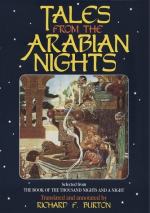[FN#75] The tale-teller forgets that Sindbad and his companions have just ascended it; but this inconsequence is a characteristic of the Eastern Saga. I may note that the description of ambergris in the text tells us admirably well what it is not.
[FN#76] This custom is alluded to by Lane (Mod Egypt, ch. xv.): it is the rule of pilgrims to Meccah when too ill to walk or ride (Pilgrimage i. 180). Hence all men carry their shrouds: mine, after being dipped in the Holy Water of Zemzem, was stolen from me by the rascally Somal of Berberah.
[FN#77] Arab. “Fulk;” some Edits. read “Kalak” and “Ramaz” (=a raft).
[FN#78] These lines occur in modified form in Night xi.
[FN#79] These underground rivers (which Dr. Livingstone derided) are familiar to every geographer from Spenser’s “Mole” to the Poika of Adelberg and the Timavo near Trieste. Hence “Peter Wilkins” borrowed his cavern which let him to Grandevolet. I have some experience of Sindbad’s sorrows, having once attempted to descend the Poika on foot. The Classics had the Alpheus (Pliny v. 31; and Seneca, Nat. Quae. vi.), and the Tigris-Euphrates supposed to flow underground: and the Mediaevals knew the Abana of Damascus and the Zenderud of Isfahan.
[FN#80] Abyssinians can hardly be called “blackamoors,” but the arrogance of the white skin shows itself in Easterns (e.g. Turks and Brahmans) as much as, if not more than, amongst Europeans. Southern India at the time it was explored by Vasco da Gama was crowded with Abyssinian slaves imported by the Arabs.
[FN#81] “Sarandib” and “Ceylon” (the Taprobane of Ptolemy and Diodorus Siculus) derive from the Pali “Sihalam” (not the Sansk. “Sinhala”) shortened to Silam and Ilam in old Tamul. Van der Tunk would find it in the Malay “Pulo Selam"=Isle of Gems (the Ratna-dwipa or Jewel Isle of the Hindus and the Jazirat al-Yakut or Ruby-Island of the Arabs); and the learned Colonel Yule (Marco Polo ii 296) remarks that we have adopted many Malayan names, e.g. Pegu, China and Japan. Sarandib is clearly “Selan-dwipa,” which Mandeville reduced to “Silha.”
[FN#82] This is the well-known Adam’s Peak, the Jabal al-Ramun of the Arabs where Adam fell when cast out of Eden in the lowest or lunar sphere. Eve fell at Jeddah (a modern myth) and the unhappy pair met at Mount Arafat (i.e. recognition) near Meccah. Thus their fall was a fall indeed. (Pilgrimage iii. 259.)
[FN#83] He is the Alcinous of our Arabian Odyssey.
[FN#84] This word is not in the dictionaries; Hole (p. 192) and Lane understand it to mean the hog-deer; but why, one cannot imagine. The animal is neither “beautiful” nor “uncommon” and most men of my day have shot dozens in the Sind-Shikargahs.
[FN#85] M. Polo speaks of a ruby in Seilan (Ceylon) a palm long and three fingers thick: William of Tyre mentions a ruby weighing twelve Egyptian drams (Gibbon ii. 123), and Mandeville makes the King of Mammera wear about his neck a “rubye orient” one foot long by five fingers large.




